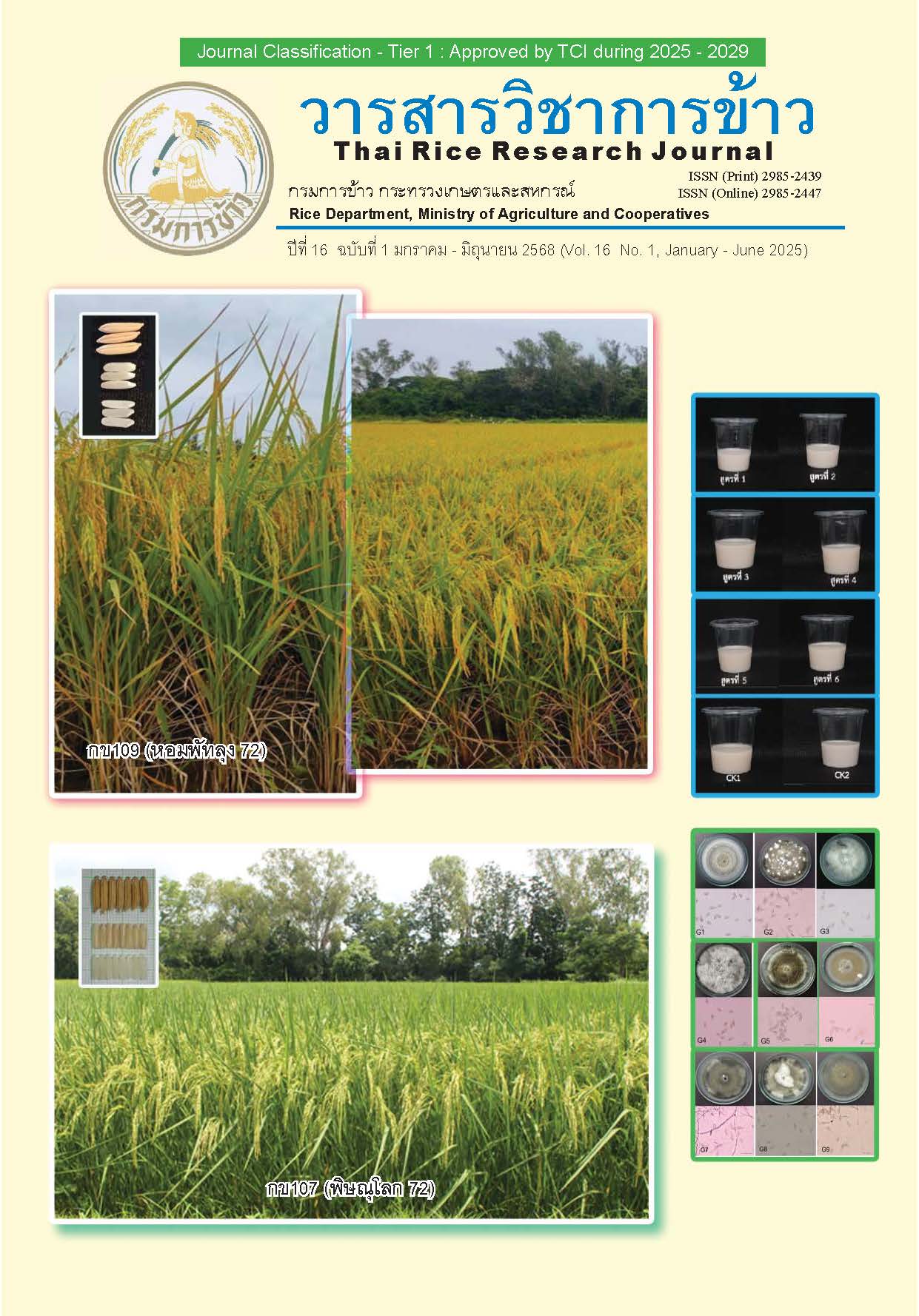Development of Oat Milk Prototype Products Planting in the Upper Northern Region
Main Article Content
Abstract
Oats contain essential vitamins, minerals and are a source of plant-based protein. This research aimed to study on sensory quality and physical-chemical properties of oat milk in northern Thailand. The experimental design was a completely randomized design (CRD) with six treatments from 3 different ratios of canola oil and 2 processed oats from baking and roasting. The results showed that the six treatments of oat milk received similar sensory scores for appearance, color and flavor but no statistically significant differences (p>0.05) with the two samples of commercial oat milk. However, the sweetness, acerbity and overall satisfaction of oat milk produced from baked oats were rated higher than those from roasted oats. The baked oat milk with canola oil 2.5% (Formula 1) received the highest acceptance in all aspects, and it received a score in every aspect close to CK1 commercial oat milk but received higher acceptance scores than CK2 commercial oat milk. The physical milk quality of Formula 1 had a lower pH than both types of commercial oat milk but had the same total soluble solid as the CK1 commercial oat milk (10 °Brix). The viscosity values of formula 1 and the CK2 commercial oat milk were similar, with 2.48 and 2.30 cP, respectively. Also, the color of formula 1 has a white color (L* = 68.42±0.06, a* = -1.31±0.01 and b* = 6.09±0.10) like a CK1 commercial oat milk (L* = 69.20±0.01, a* = -1.23±0.01 and b* = 5.26±0.02). The chemical composition of formula 1 contained carbohydrates (12.64%), protein (1.28%), fat (1.28%), fiber (1.81%), ash (0.12%), and moisture (82.87%).
Article Details
References
กรมส่งเสริมการค้าระหว่างประเทศ. 2567ก. การนำเข้าและส่งออกสินค้าธัญพืช. สืบค้นจาก: https://www.ditp.go.th/international-foreign-market. (27 มีนาคม 2567)
_________________________________. 2567ข. “ข้าวโอ๊ต” ยอดจำหน่ายพุ่งสูง อาหารเพื่อสุขภาพกระแสใหม่ ผู้หญิงช่วงวัย 20 และ 30 หันมาบริโภคแทนข้าว. สืบค้นจาก: https://www.ditp.go.th/contents_attach/735491/735491.pdf. (27 มีนาคม 2567)
_________________________________. 2567ค. สินค้านมจากพืชในสิงคโปร์. สืบค้นจาก: https://www.ditp.go.th/post/157163. (27 มีนาคม 2567)
กรุงเทพธุรกิจ. 2567. ส่องตลาด “นมข้าวโอ๊ต” ในไทย ทำไมถึงฮิต แม้ “ราคาสูง”. สืบค้นจาก: https://www.bangkokbiznews.com/business/business/1022299. (27 มีนาคม 2567)
กานต์ธิดา วดีศิริศักดิ์. 2565. ผลิตภัณฑ์หมักจากน้ำนมพืชและคุณสมบัติเชิงหน้าที่. วารสารวิจัยและพัฒนาผลิตภัณฑ์อาหาร 52(4): 14-26.
ชูศักดิ์ จอมพุก. 2555. สถิติ : การวางแผนการทดลองและการวิเคราะห์ข้อมูลในงานวิจัยด้านพืชด้วย “R”. พิมพ์ครั้งที่ 2 ฉบับปรับปรุง. มหาวิทยาลัยเกษตรศาสตร์, กรุงเทพฯ. 335 หน้า.
สิปปวิชญ์ ปัญญาตุ้ย. 2566. การประเมินศักยภาพเชิงพื้นที่และอิทธิพลของวันปลูกต่อการผลิตข้าวสาลีสายพันธุ์ดีเด่นในพื้นที่จังหวัดเชียงใหม่และแม่ฮ่องสอน. ดุษฎีนิพนธ์ สาขาพืชไร่ มหาวิทยาลัยแม่โจ้. 170 หน้า.
สิปปวิชญ์ ปัญญาตุ้ย. 2567. รายงานฉบับสมบูรณ์ เรื่อง การพัฒนาศักยภาพการผลิตธัญพืชเมืองหนาวสู่เศรษฐกิจสร้างสรรค์มูลค่าสูง. กองวิจัยและพัฒนาข้าว, กรมการข้าว.
Amagliani, L., J. O’Regan, A.L. Kelly and J.A. O’Mahony. 2017. The composition, extraction, functionality and applications of rice proteins: A review. Trends in Food Science & Technology 64: 1-12.
AOAC. 2005. Official Methods of Analysis. 18th ed. AOAC International. Guithersburg, Maryland, U.S.A. 3172 pp.
Aydar, E.F., S. Tutuncu and B. Ozcelik. 2020. Plant-based milk substitutes: Bioactive compounds, conventional and novel processes, bioavailability studies, and health effects. Journal of Functional Foods 70: 10397.
Cruz, N., M. Capellas, M. Hernández, A.J. Trujillo, B. Guamis and V. Ferragut. 2007. Ultra high pressure homogenization of soymilk: microbiological, physicochemical and microstructural characteristics. Food Research International 40: 725-732.
Giri, S.K. and S. Mangaraj. 2012. Processing influences on composition and quality attributes of soymilk and its powder. Food Engineering Reviews 4(3): 149-164.
Iglesias-Figueroa, B.F., E.A. Espinoza-Sánchez, T. Siqueiros-Cendón and Q. Rascón-Cruz. 2019. Lactoferrin as a nutraceutical protein from milk, an overview. International Dairy Journal 89: 37-41.
Maghsoudlou, Y., M. Alami, M. Mashkour and M.H. Shahraki. 2016. Optimization of ultra-soundassisted stabilization and formulation of almond milk. Journal of Food Processing and Preservation 40(5): 828-839.
Mäkinen, O.E., V. Wanhalinma, E. Zannini and E.K. Arendt. 2016. Foods for special dietary needs: Non-diary plant-based milk substitutes and fermented diary-type products. Critical Reviews in Food Science and Nutrition 56(3): 339-349.
Munekata, P.E.S., R. Domínguez, S. Budaraju, E. Roselló-Soto, F.J. Barba, K. Mallikarjunan, S. Roohinejad and J.M. Lorenzo. 2020. Effect of innovative food processing technologies on the physicochemical and nutritional properties and quality of non-dairy plant-based beverages. Foods 9(3): 288.
Palmett Ríos, H.E. 2017. Cross-sectional study on healthy lifestyles and their relationship with HDL cholesterol in the adult population. Revista Colombiana de Cardiología 24(5): 523-531.
Sethi, S., S.K. Tyagi and R.K. Anurag. 2016. Plant-based milk alternatives an emerging segment of functional beverages: A review. Journal of Food Science and Technology 53(9): 3408-3423.
Yuan, S., S.K.C. Chang, Z. Liu and B. Xu. 2008. Elimination of trypsin inhibitor activity and beany flavor in soy milk by consecutive blanching and ultrahigh-temperature (UHT) processing. Journal of Agricultural and Food Chemistry 56(17): 7957-7963.

